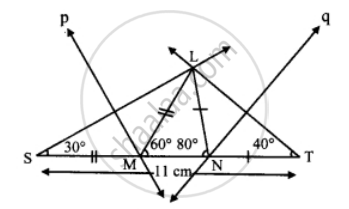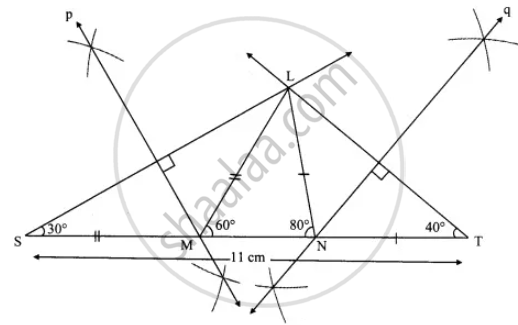Advertisements
Advertisements
Question
Construct ΔLMN, in which ∠M = 60°, ∠N = 80° and LM + MN + NL = 11 cm.
Solution
Rough figure:

Explanation:
(i) As shown in the figure, take point S and T on line MN, such that
MS = LM and NT = LN ...(i)
MS + MN + NT = ST ...[S-M-N, M-N-T]
∴ LM + MN + LN = ST ...(ii)
Also,
LM + MN + LN = 11 cm …(iii)
∴ ST = 11 cm ...[From (ii) and (iii)]
(ii) In ∆LSM
LM = MS
∴ ∠MLS = ∠MSL = x° ...(iv) [isosceles triangle theorem]
In ∆LMS, ∠LMN is the exterior angle.
∴ ∠MLS + ∠MSL = ∠LMN ...[Remote interior angles theorem]
∴ x + x = 60° ...[From (iv)]
∴ 2x = 60°
∴ x = 30°
∴ ∠LSM = 30°
∴ ∠S = 30°
Similarly, ∠T = 40°
(iii) Now, in ∆LST
∠S = 30°, ∠T = 40° and ST = 11 cm
Hence, ALST can be drawn.
(iv) Since, LM = MS
∴ Point M lies on perpendicular bisector of seg LS.
Also LN = NT
∴ Point N lies on perpendicular bisector of seg LT.
∴ Points M and N can be located by drawing the perpendicular bisector of LS and LT respectively.
∴ ∆LMN can be drawn.
Steps of construction:
- Draw seg ST of length 11 cm.
- From point S draw ray making angle of 30°.
- From point T draw ray making angle of 40°.
- Name the point of intersection of two rays as L.
- Draw the perpendicular bisector of seg LS and seg LT intersecting seg ST in M and N respectively.
- Join LM and LN.
Therefore, ∆LMN is the required triangle.

